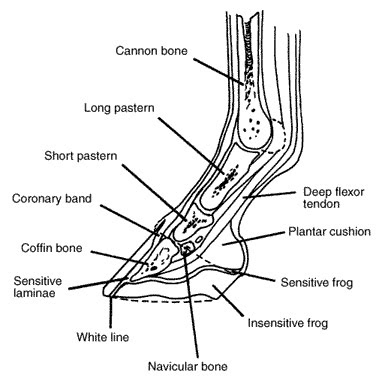I'll start with the landmarks on the bottom of the foot, Marjorie Smith has a great diagram for this:
Learn all of these.
It's also helpful to know that bones that make up the hoof and the bottom of the leg. I picked this next photo because it's very simple to see the bones and how they fit together:
This graphic is not so simple but highlights more of the structures that you should know about:
These are what I recommend you spend your brain power learning (they all have multiple names just to be really confusing):
- P1 - proximal phalanx - long pastern
- P2 - middle phalanx - short pastern
- P3 - distal phalanx - coffin bone/pedal bone
- Navicular bone - distal sesamoid
- Deep flexor tendon - deep digital flexor tendon
- Coronary band - coronet band
- Plantar cushion - digital cushion
It might help to think of the horse's lower leg as analogous to our hands and feet. The cannon bone is the "same" as one of our metacarpals or metatarsals (the bones inside our foot or palm), while the three bones inside the fetlock and hoof are analogous to the bones in our fingers or toes, only in humans we call those bones phalanges and not phalanxes. Unlike us, walking around with all our weight on our cannon bones and hocks, horses walk around on the ends of four toes. Horses used to have more toes, a couple million years ago, their vestigial remains are now called splint bones.
 |
| Why hello there, cute little horse ancestor |



I seem to have learned the parts of a horse's hoof the hard way, because I only have memorized the parts that have had issues. :/ This is great information.
ReplyDeleteSadly that's how most of us learn about hooves :(
ReplyDeleteInterseting timing on both these posts. I have been trying to get to the bottom of what has caused Storm's perfectly round right front to turn into an oblong thing a little on the club side. Then there's the issue of what i can do to correct it and hopefully get back the great foot he was born with.
ReplyDeleteI would guess that the problem with Storm's feet is bad trimming combined with minimal turnout. I've got a few more of these posts coming, hopefully one of them will answer your questions.
ReplyDeleteGood post! Looking forward to the next one.
ReplyDeleteI hope I don't let you down, Wolfie.
ReplyDeleteThanks for the nice diagrams. I'm currently learning the German words for the parts so I can have conversations with people here about them. The word for Navicular Syndrome had me wondering for a while.
ReplyDeleteI am always fascinated by what illnesses are more prevalent here and why. Navicular is widespread - hm..why? I suppose my lack of exposure to the jumping world has kept me in the dark about the prevalence in America. I will be watching to see if Navicular is common amongst non-jumpers. Now I have to spotlight some of the unbelievable "treatment packages" for Navicular syndrome that I've found. I have got to stop saying "Now I've seen everything!"
I think Sesamoiditis is the same thing as Navicular Syndrome - is that so?
Is it the same thing? I'm not sure. Since the navicular bone is also known as the distal sesamoid it might be, but there's also a sesamoid where the cannon bone articulates with the long pastern bone.
ReplyDeleteI'm debating whether I should do a post about navicular or not. In general I've come to the conclusion that a diagnosis of navicular is really a "non-diagnosis." The vet knows the horse's foot hurts but darned if they can figure out why- so they slap "navicular disease" on the horse and move on.
and then the creative shoeing begins! wait til you see the pics i found..
ReplyDelete